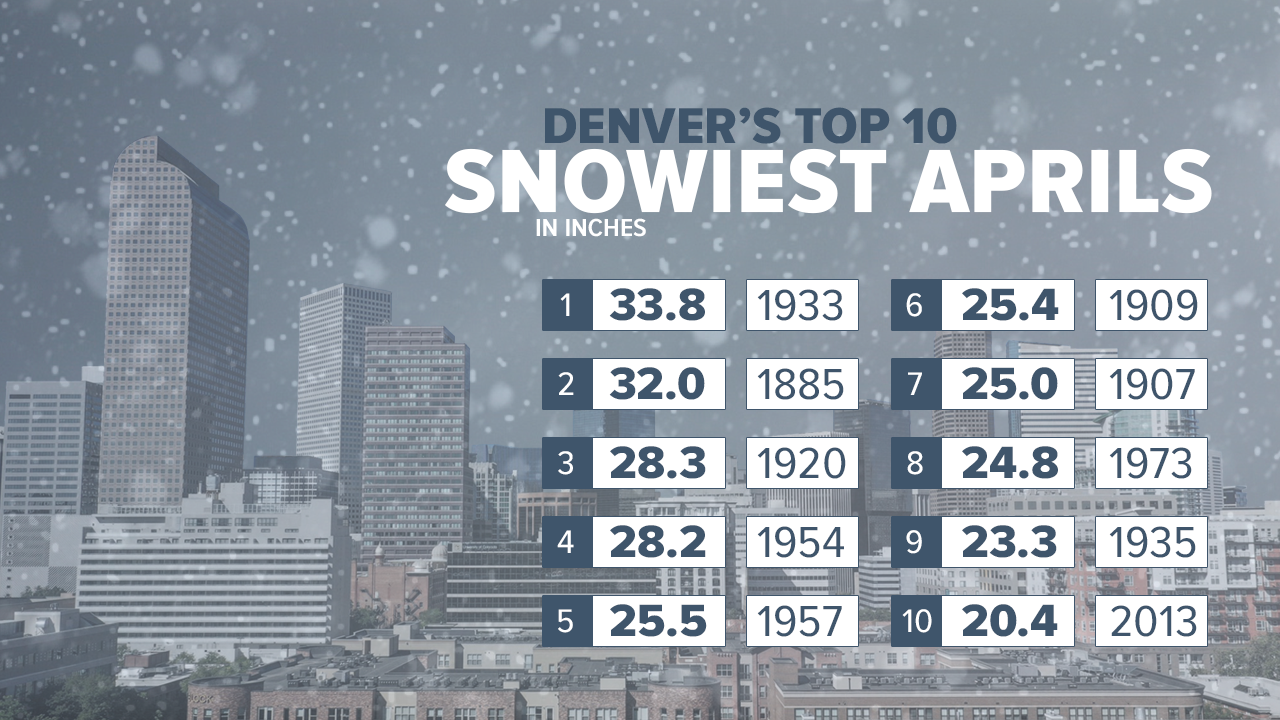April has arrived and the fast-changing weather means the start of severe weather and thunderstorm season for the Denver metro area as the transition from winter to spring moves into high gear.
The month is typically warmer (compared to March) with less snowfall but more rain. In fact, Denver's second wettest month in history occurred during this time of year--April 1900 to be exact, according to the National Weather Service.
During the month, outdoor enthusiasts can enjoy a deep snowpack at higher elevations while experiencing warm spring-like temperatures in the 80s at lower elevations.

Denver's monthly mean temperature for April is 47.4 degrees, according to the averages taken from the years 1981 through 2010. But the city has seen temperatures as warm as 90 degrees and as cold as -2 degrees during this month.
April is Denver's 6th coldest month of the year. The month starts with a normal high of 58 degrees and ends with a normal high of 66 degrees. For low temperatures, the month begins with a normal of 30 degrees and finishes with a normal of 37, according to the NWS.

And just because the calendar says April, it doesn't mean we're done with the snow. April ranks as the 5th snowiest month and accounts for approximately 13% of the annual snowfall of 53.8 inches, according to the NWS. Denver sees about 8-10 inches on average during the month.

Denver's 5th biggest snowstorm in history occurred in April of 1885 and buried the city in 23 inches of snow in less than a day. When was the snowiest April in Denver? That occurred in 1938 when a total of 33.8 inches of snow fell on the Mile High City during the month.

And a lot of this moisture comes from what is called the classic upslope storm, which can dump heavy amounts of snow along the Front Range. An upslope storm develops when a low-pressure system forms on the Great Plains and pushes moist air up against the foothills of the Rocky Mountains where it falls as snow or rain.
This time of year, we also see an increase in the chances that severe weather will make its presence known, marking the beginning of severe weather and thunderstorm season on the Front Range. Precipitation in the form of sleet and small hail is also common with April thunderstorms.

Colorado's extreme weather events have made forecasting in the Centennial State challenging at times. From mountain tornadoes to snow in June, Colorado's spring weather can get a little tipsy and should be told to go home. But tragically at the same time, it can turn deadly and be destructive, even in April.
In the early morning hours of April 27, 2012, a rare weather occurrence rattled Southeast Colorado. Five tornadoes, ranging in severity from EF1 to EF2, spawned by a strong storm system touched down in Prowers, Kiowa and Bent counties, injuring at least eight people and destroying homes and businesses. No fatalities were reported.
Denver7 Chief Meteorologist Mike Nelson provides an outlook on April weather and explains some of the extreme weather statistics and the phenomenon known as upslope storms. Watch the video in the player below:
But despite the increase in severe weather activity this month, May is typically when the severe weather season really heats up.
Tornado season
Peak tornado season is just around the corner. The tornado threat in Colorado increases rapidly in May and continues through August, with June being the busiest month with an average of 17 tornadoes, according to the National Oceanic and Atmospheric Administration.
Ninety percent of Colorado tornadoes occur during this four month period, but tornadoes have been reported as early as February and as late as November. On average, Colorado experiences 53 tornadoes annually.
There have been 2,125 tornado events recorded in Colorado and at least five deaths related to twisters since 1950.

The most tornado-prone county in Colorado and the entire country is Weld County, which has seen 268 tornadoes since 1950. The city and county of Denver has seen 16 tornadoes in the same period, the most powerful — an EF-3 — hitting on June 15, 1988. The strongest tornado to hit the state was an EF-4 in 1977, according to NOAA.
The tornadic activity doesn't always occur in the usual places in Colorado. Although extremely rare, tornadoes and funnel clouds have been spotted on the Western Slope and in high-altitude areas.
The Denver7 360 In-Depth team charted an overall and detailed look at what to expect from the weather in April. The infographics tell the story of what to expect on a typical day as well as how much of a warm up to expect over the course of the month (according to the averages).
In this Denver7 360 In-Depth deep dive 📈
- Preview Denver's April weather 🌤
- Check the normal high/low by day ☀️
- Compare record low and high temperatures ☀️
- A look back at a rare April tornado outbreak in SE Colorado 🌪
- The wettest Aprils on record 🌧
To view April stats and data fullscreen on your computer or phone click here.




